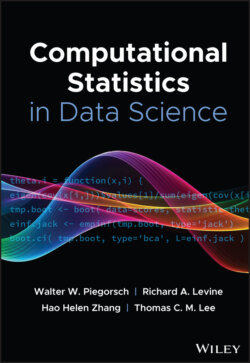Читать книгу Computational Statistics in Data Science - Группа авторов - Страница 134
7.2 Estimating Risk for Empirical Bayes
ОглавлениеRisk of empirical Bayes estimators is often not available in closed form, and Monte Carlo simulation is used to estimate it. Consider Example 3.3 from Robert and Casella [4] where for a fixed ,
The posterior distribution of (given ) is
If the true value of is unknown, it is often estimated from the marginal distribution of , via maximum‐likelihood estimation as
Robert and Casella [4] consider estimating using the posterior mean . Under a quadratic loss, the Bayes estimator is
The risk for
is difficult to obtain analytically (although not impossible, see Robert and Casella [4]). Instead, we can estimate the risk over a grid of values using Monte Carlo. To do this, we fix choices over a grid, and for each , generate Monte Carlo samples from yielding estimates
The resulting estimate of the risk is an ‐dimensional vector of means, for which we can utilize the sampling distribution in Theorem 1 to construct large‐sample confidence regions. An appropriate choice of a sequential stopping rule here is the relative‐magnitude sequential stopping rule, which stops simulation when the Monte Carlo variance is small relative to the average risk over all values of considered. It is important to note that the risk at a particular could be zero, but it is unlikely.
For illustration, we set and simulate a data point from the true model with . To evaluate risk we choose a grid of values with . In order to assess the appropriate Monte Carlo sample size , we set so that at least Monte Carlo samples are obtained. With , and estimated using the sample covariance matrix, the sequential stopping rule terminates simulation at 21 100 steps. Figure 2 demonstrates the estimated risk at iterations and the estimated risk at termination. Pointwise Bonferroni corrected confidence intervals are presented as an indication of variability for each component1.
Figure 2 Estimated risk at (a) and at (b) with pointwise Bonferroni corrected confidence intervals.
